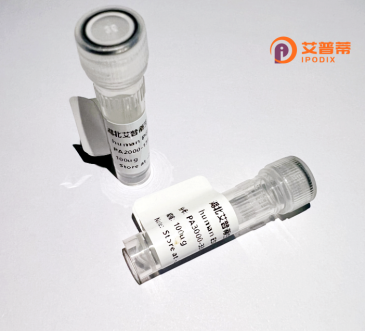
| 纯度 | >90%SDS-PAGE. |
| 种属 | Human |
| 靶点 | STXBP4 |
| Uniprot No | Q6ZWJ1 |
| 内毒素 | < 0.01EU/μg |
| 表达宿主 | E.coli |
| 表达区间 | 1-553 aa |
| 活性数据 | MNKNTSTVVS PSLLEKDPAF QMITIAKETG LGLKVLGGIN RNEGPLVYIQ EIIPGGDCYK DGRLKPGDQL VSVNKESMIG VSFEEAKSII TGAKLRLESA WEIAFIRQKS DNIQPENLSC TSLIEASGEY GPQASTLSLF SSPPEILIPK TSSTPKTNND ILSSCEIKTG YNKTVQIPIT SENSTVGLSN TDVASAWTEN YGLQEKISLN PSVRFKAEKL EMALNYLGIQ PTKEQHQALR QQVQADSKGT VSFGDFVQVA RNLFCLQLDE VNVGAHEISN ILDSQLLPCD SSEADEMERL KCERDDALKE VNTLKEKLLE SDKQRKQLTE ELQNVKQEAK AVVEETRALR SRIHLAEAAQ RQAHGMEMDY EEVIRLLEAK ITELKAQLAD YSDQNKESVQ DLKKRIMVLD CQLRKSEMAR KTFEASTEKL LHFVEAIQEV FSDNSTPLSN LSERRAVLAS QTSLTPLGRN GRSIPATLAL ESKELVKSVR ALLDMDCLPY GWEEAYTADG IKYFINHVTQ TTSWIHPVMS VLNLSRSEEN EEDCSRELPN QKS |
| 分子量 | 61.6 kDa |
| 蛋白标签 | His tag N-Terminus |
| 缓冲液 | PBS, pH7.4, containing 0.01% SKL, 1mM DTT, 5% Trehalose and Proclin300. |
| 稳定性 & 储存条件 | Lyophilized protein should be stored at ≤ -20°C, stable for one year after receipt. Reconstituted protein solution can be stored at 2-8°C for 2-7 days. Aliquots of reconstituted samples are stable at ≤ -20°C for 3 months. |
| 复溶 | Always centrifuge tubes before opening.Do not mix by vortex or pipetting. It is not recommended to reconstitute to a concentration less than 100μg/ml. Dissolve the lyophilized protein in distilled water. Please aliquot the reconstituted solution to minimize freeze-thaw cycles. |
以下是3篇关于重组人STXBP4蛋白的参考文献摘要:
---
1. **"STXBP4 regulates TGF-β signaling and epithelial-mesenchymal transition in breast cancer"**
*Kang, Y. et al. (2018)*
该研究揭示了STXBP4通过结合Smad蛋白并抑制其核转位,负调控TGF-β信号通路,从而抑制乳腺癌细胞的迁移和转移,实验中使用了重组STXBP4验证其与Smad的相互作用。
2. **"Munc18c mediates insulin-stimulated GLUT4 translocation in adipocytes"**
*Mallard, F. et al. (2002)*
本文发现Munc18c(STXBP4)与Syntaxin 4的相互作用参与胰岛素刺激下GLUT4囊泡的膜融合,重组Munc18c蛋白被用于体外结合实验,证实其调控葡萄糖转运的关键作用。
3. **"STXBP4 interacts with Hsp70 to promote proteasomal degradation of oncogenic proteins in colorectal cancer"**
*Oh, S. et al. (2015)*
研究显示,STXBP4通过结合Hsp70促进致癌蛋白的泛素化降解,抑制结直肠癌进展。实验利用重组STXBP4蛋白阐明了其与Hsp70的分子结合机制。
---
以上文献涵盖了STXBP4在信号通路调控、膜运输及癌症中的作用,均涉及重组蛋白的功能验证。如需具体DOI或期刊名,可进一步补充检索。
**Background of Recombinant Human STXBP4 Protein**
STXBP4 (Syntaxin-Binding Protein 4), also known as PSCD3 or SLP-4. is a member of the STXBP family that interacts with soluble NSF attachment protein receptors (SNAREs) to regulate intracellular vesicle trafficking and membrane fusion. Initially identified as a binding partner of syntaxins, STXBP4 contains a conserved SEC1-like domain, enabling its role in mediating protein-protein interactions critical for secretory pathways. Unlike other STXBP members (e.g., STXBP1 in synaptic vesicles), STXBP4 is broadly expressed in tissues like the brain, pancreas, and kidney, suggesting diverse cellular functions.
Studies link STXBP4 to cancer biology, notably as a tumor suppressor. It inhibits epithelial-mesenchymal transition (EMT) by sequestering ERBB2IP, a promoter of TGF-β signaling, thereby suppressing metastasis in colorectal and breast cancers. Conversely, STXBP4 may act contextually as an oncogene in hepatocellular carcinoma by stabilizing oncoproteins. Recombinant human STXBP4 protein, typically produced in *E. coli* or mammalian systems, retains functional domains for *in vitro* studies, including SNARE complex assembly assays or drug screening. Its molecular weight ranges around 50-55 kDa, with purification tags (e.g., His-tag) facilitating isolation. Ongoing research explores its dual roles in cell signaling and therapeutic potential, highlighting its importance in membrane dynamics and disease pathology.
×